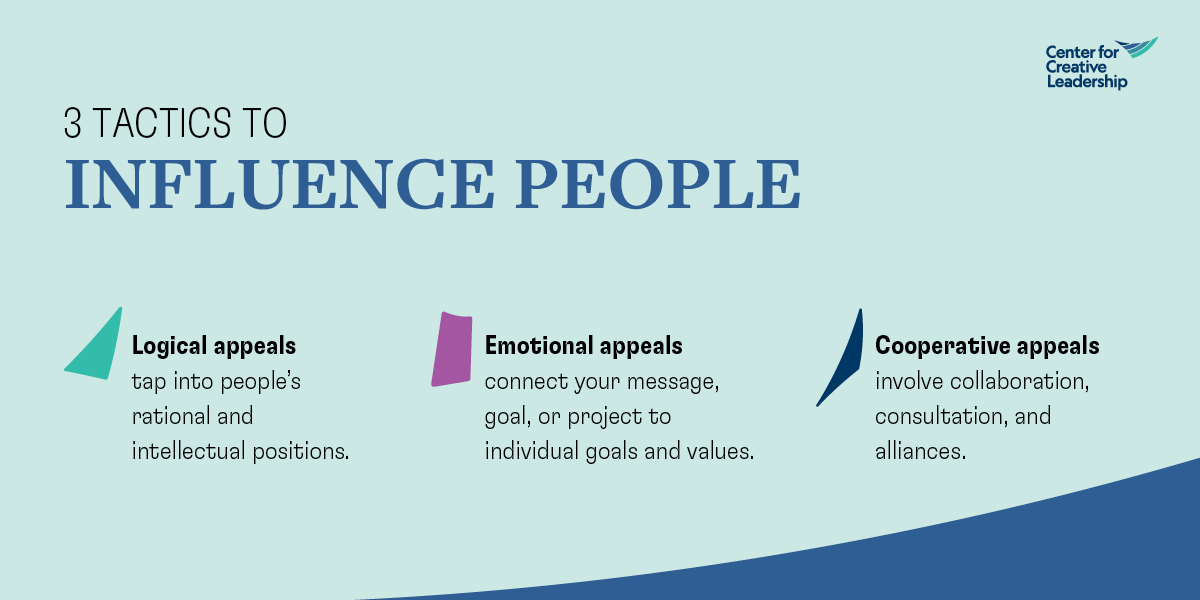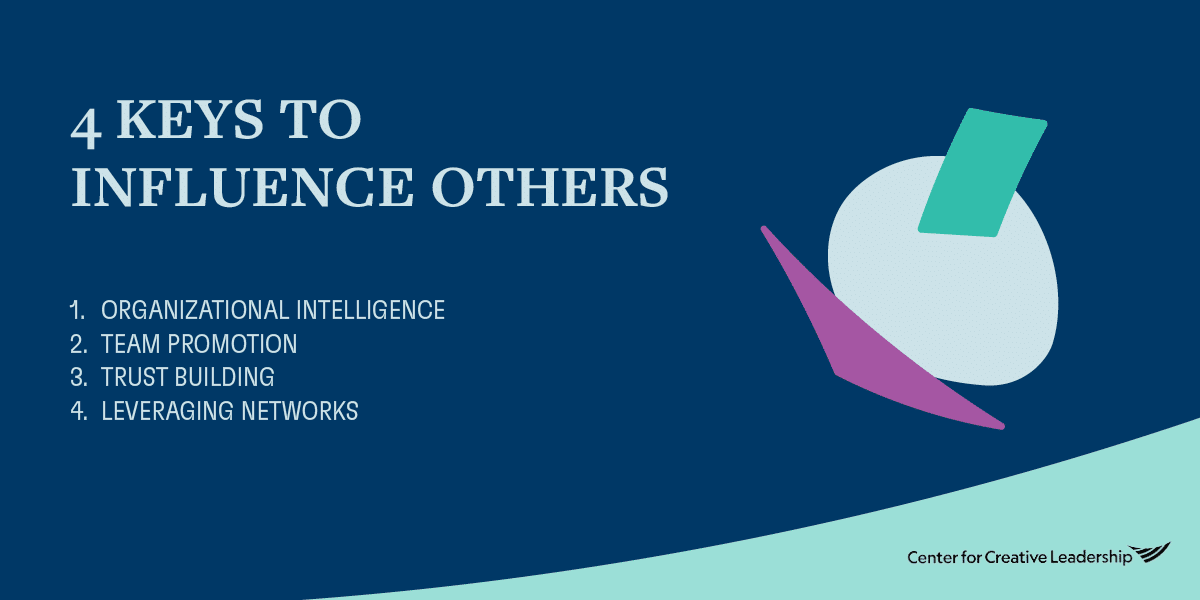To be truly effective — in good times and in times of great challenge — leaders must know how to influence people. By definition, influence is the ability to affect the behavior of others in a particular direction, leveraging key tactics that involve, connect, and inspire them.
That’s why we’ve identified “influencing others” as one of the 4 core leadership skills needed in every role. (Communicating, learning agility, and self-awareness are the other 3.)
Without the expertise and ability to influence others, the truly important things in work and in life can’t be achieved.
But effective leaders don’t just command; they inspire, persuade, and encourage. Leaders tap the knowledge and skills of a group, point individuals toward a common goal and consensus, and draw out a commitment to achieve results.
Influencing People Varies by Role
Early in your career, or in individual contributor roles, influence is about working effectively with people over whom you have no authority. It requires the ability to present logical and compelling arguments and engage in give-and-take.
When leading from the middle, you’ll want to focus particularly on developing the 4 key skills needed to influence others, which we expand on below.
In senior-level or executive roles, influencing others is more about steering long-range objectives, inspiring and motivating others, and communicating the vision.
But wherever you are in an organization, chances are you’ll want to master tactics to influence people, as influence is one of the 4 core leadership skills needed in every role.
“Without the capacity to influence others, your ability to make what you envision a reality remains elusive because, after all, no one can do it alone,” notes George Hallenbeck, a lead contributor to our Lead 4 Success® program, which helps leaders develop these 4 key essentials of leadership.
Influencing Others: 4 Key Skills
4 Influencing Skills
The best leaders have these 4 key influencing skills:
- Organizational Intelligence: They understand how to get things done and embrace the reality of working within organizational politics to move teams and important initiatives forward.
- Team Promotion: Leaders cut through the noise to authentically and credibly promote themselves — while also promoting what’s good for the entire organization.
- Trust-Building: Because leadership often involves guiding people through risk and change, trust is essential.
- Leveraging Networks: No leader is an island. They are empowered by their connections with others.
Here’s a look at each of these influencing skills in a little more detail, and how you and your team can use them to influence others.
1. Practice “Organizational Intelligence.”
All organizations have 2 sides: the formal structure pictured on the org chart and the informal structure, which more often represents how things really get done. Politically savvy leaders understand both.
Political savvy is both a mindset and a skillset. Savvy leaders view politics as a neutral and necessary part of organizational life that can be used constructively and ethically to advance organizational aims.
For a leader, political skills in action look like:
- Networking to build social capital, including mingling strategically.
- Thinking before responding, considering context and goals before deciding when and how to express their point of view.
- Paying close attention to nonverbal cues, practicing active listening, considering how others might feel, and finding ways to appeal to the common good.
- Leaving people with a good impression, without coming across as “trying too hard.”
2. Promote Yourself, Promote Your Team.
Self-promotion is often seen as bragging or selfishness. But leaders who know how to influence people understand that by promoting themselves authentically and for the right reasons, they can cut through the information that bombards us all each day.
In the hands of an astute leader, authentic self-promotion isn’t just a tool to advance one’s own career. It can provide visibility and opportunities for their direct reports, generate team and organizational pride, and make capabilities and ideas more visible across the organization — ultimately enhancing collaboration and consensus.
Two self-promotion strategies stand out.
First, leaders who are good at influencing others find ways to gather an audience. They may ask more people to be part of a team, initiative, or problem-solving process.
Second, they find ways to “put on a show” and step into the spotlight at selected events and meetings, sometimes creating their own events.
3. Build & Maintain a Foundation of Trust.
Building and maintaining leadership trust is essential. Without trust, leaders may be able to force people to comply, but they’ll never tap the full commitment, capabilities, and creativity the group can offer. Leveraging these assets is invaluable when tackling tough challenges or making strategic change, so trust is vital.
People look for leaders who can appreciate their vulnerability and inspire them, understand them, support them, and guide them through looming chaos. This requires the leader to demonstrate a broad range of expertise and behaviors, some of which might seem contradictory but, when used in an appropriate and timely manner, create conditions that foster trust.
Trust involves a careful balance between pushing people into areas where they’re uncomfortable while also listening carefully to their concerns and feedback. Among the many “balancing acts” they must work to maintain, trustworthy leaders negotiate between toughness and empathy as individuals struggle with transition, as well as urgency with patience as change proceeds.
4. Leverage Networks.
Finally, leaders that know how to influence people recognize and cultivate the power of networks. Organizations are increasingly dynamic; they morph in size and shape over time. Influential leaders have a network perspective and recognize that their personal networks must also be dynamic and growing. They’re also strategic about choosing how and when to tap into this network.
Access Our Webinar!
Learn more about the key elements of effective influencing skills, including how to assess your current influencing capabilities and competencies to become a more influential leader, when you watch our webinar, Being an Influential Leader: How Effective Influencing Can Be a Game-Changer.
When Influencing Others, Remember Context Matters
Across all 4 of these influencing skills — political savvy, self-promotion, building trust, and networking — context is important.
The goal is to influence others, not manipulate them.
Effective, ethical leaders use different approaches in different situations, choosing carefully when and how to influence people using influencing tactics that appeal to the head, heart, or hands. For example, a leader may use rational persuasion techniques when there’s factual evidence to present. On the other hand, they may opt to use inspirational appeals or consultation methods to generate buy-in when discussing a new project or proposal with their team.
3 Tactics for Influencing Others
We’ve found that influencing tactics fall into 3 categories: logical, emotional, or cooperative appeals. In other words, using the head, heart, or hands to influence people:
- Logical Appeals (Head): Tap into people’s rational and intellectual positions. You present an argument for the best choice of action based on organizational benefits, personal benefits, or both, to appeal to people’s minds.
- Emotional Appeals (Heart): Connect your message, goal, or project to individual goals and values. An idea that promotes a person’s feelings of wellbeing, service, or sense of belonging tugs at the heartstrings and has a good chance of gaining support.
- Cooperative Appeals (Hands): Involve collaboration, consultation, and alliances. Working together to accomplish a mutually important goal extends a hand to others in the organization and is an extremely effective way to influence people. Leaders who effectively use these tactics to influence people can achieve their goals and objectives more successfully than leaders who lack that ability, regardless of where they sit in an organization.

Leaders need to understand why they’re doing something — and be clear about their own values, goals, and point of view when applying their influence skills and planning their approach.
That way, influencing others comes from a place of authenticity and has the greatest impact.
Unsure where to start? Think about a situation in the near future when you will need to influence someone, and reflect on the following questions to form a plan:
- Who am I attempting to influence?
- What is the situation? How much support do I need?
- Why do I need this person’s support of my idea?
- What tactics can I use, and how can I establish rapport?
- What responses do I anticipate?
- What mutual points of agreement can I use?
- How can I end on a positive note, no matter what the outcome is?
How to Recognize When You’re Being Influenced
When you’re a leader who is used to being the influencer, it can be challenging to identify when the tables have been turned. If fellow teammates or executives are trying to persuade you, it’s important to recognize when and how you’re being influenced.
To start, gain some self-awareness about your own biases and personal point of view. Determine your current strengths and development needs, and understand that you will typically act out of your strengths.
Ask yourself, “What will it take for me to be more aware and balance my typical approach to be more effective with others?”
The better you understand yourself, the better you’ll be at understanding others. If you do find yourself being influenced, consider leveraging the consultation tactic in response to offer up your thoughts, desires, and suggestions for discussion. This type of collaboration will be an especially helpful technique if you disagree and need to negotiate a path forward. You may discover that the time you’ve spent thinking about the most effective way to influence others will come in very handy.
Ready to Take the Next Step?
Upskill your team by building their capacity to influence others successfully. Partner with us for a customized learning journey for your leaders using our research-based modules. Available leadership topics include Authentic Leadership, Communication, Emotional Intelligence, Influence Skills Training, Listening to Understand, Self-Awareness, and more.








